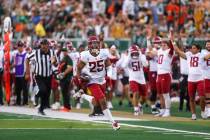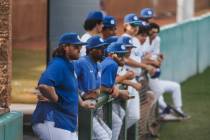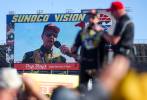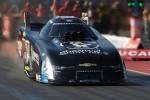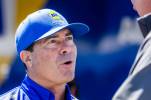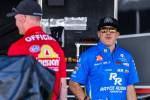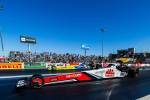NHRA drags feet with failure to reduce speeds
If the hierarchy of the National Hot Rod Association were running NASCAR in 1989 when stock cars needed to be slowed, the drag racing czars would have coned off the outer half of high-banked corners on ovals at Daytona and Talladega.
That would have worked, but instead of altering the tracks, NASCAR opted to slow speeds by altering the cars.
That's something NHRA -- drag racing's premier sanctioning body -- should have started to do when Tony Schumacher reached 330 mph in 1999 and certainly after Gary Scelzi became the first Funny Car driver to reach that milestone five years later.
Instead, NHRA helped market souvenir items promoting "Speed Limit 330 MPH." But that wasn't the limit. Since then, Schumacher has gone as fast at 336 and Jack Beckman 333 in a Funny Car.
Speeds have been held down slightly over the past year or two, when NHRA issued minor rule changes, but nothing drastic has been done to boost safety by slowing the sport's two fastest categories and bringing all dragstrips into the 21st century.
Effective with today's NHRA Powerade Drag Racing event near Denver, racing for Top Fuel and Funny Car will be limited to 1,000 feet while other categories in the event will race for the traditional 1,320 feet.
The mandate to shorten races for supercharged, nitro-fueled cars is likely to last the rest of the season.
NHRA's procrastination in regard to lower speeds forced it to make that "interim" move to show it was reacting to prevent another deadly crash like the one Scott Kalitta suffered June 21 in an NHRA event at Englishtown, N.J.
The first deadly domino for Kalitta was an engine explosion and fire at 1,100 feet. A second explosion occurred when his Funny Car slammed into a steel pole supporting a safety net that probably couldn't have caught a cold.
The explosions didn't kill Kalitta; crashing into an ineffective shutdown area did.
Drivers assume a track is safe when an NHRA official directs them to ignite their engines for a run; they put their trust in NHRA.
Tragically, it took another dead racer to illuminate the genius bulbs at NHRA to existing problems. Deadly problems.
Shortening the races will give the fuel cars another 320 feet to slow. NHRA took the path of least resistance.
Another indication there's something wrong at NHRA was the apparent absence of president Tom Compton on the teleconference call last week with national event track operators when the shorter-is-better edict was announced.
NHRA was represented on the call by vice presidents Graham Light and Peter Clifford. If Compton was in the room, he never uttered a sound. He didn't even have a comment in the NHRA news release about the decision.
How can the president and leader of NHRA not be involved with that announcement? It's the biggest rule change in the 57-year history of NHRA.
Compton should be removed from office, unless he was in a coma or on his deathbed that day. And the latter conditions also should lead to his ouster.
Leadership at NHRA isn't coming from the top. It's coming from team owners, and the inmates shouldn't be running the asylum.
Fans are being taken for granted with this decision because of their loyalty and support for any safety initiative.
NHRA assumes its customers will not protest shortening races by 320 feet -- about 25 percent of a quarter-mile -- because of their passion for drag racing and love of its competitors.
To show support for the fans, NHRA should cut ticket prices by 25 percent for any 1,000-foot event, and NHRA should absorb the revenue shortfall, not the tracks.
It's NHRA that has been smoking its tires over slowing its fastest cars. Getting a new leader for NHRA would be an even quicker fix.
Jeff Wolf's motor sports column is published Friday. He can be reached at 383-0247 or jwolf@reviewjournal.com. Visit Wolf's motor sports blog at lvrj.com/blogs/heavypedal/ throughout the week.








